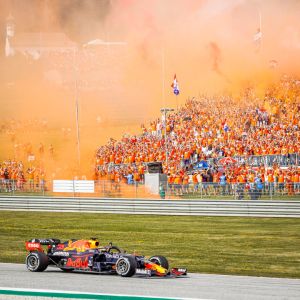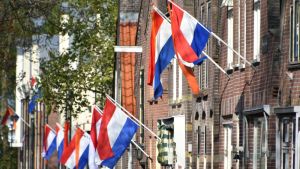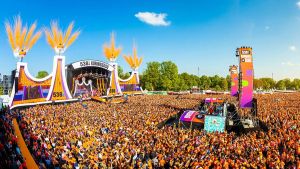m (Separate a paragraph to avoid confusion.) |
m (Elaborate on why the title is important to the Dutch monarchy. Spell check.) Tag: 2017 source edit |
||
| (2 intermediate revisions by the same user not shown) | |||
| Line 7: | Line 7: | ||
}} | }} | ||
During each edition of r/Place, a band of orange manifested on top of the canvas and bordered | During each edition of r/Place, a band of orange manifested on top of the canvas and bordered the [[Netherlands Flag|flag of The Netherlands]] below. The band of orange is not part of the flag, but the members of [[PlaceNL]] considered it essential to include it every time. | ||
[[File:koningsdag-vlaggen-met-wimpels.jpg|thumb|The flags are raised with the orange pennant on King's Day.]] | [[File:koningsdag-vlaggen-met-wimpels.jpg|thumb|The flags are raised with the orange pennant on King's Day.]] | ||
The band of orange could either represent the orange pennant that's flown with the flag during national holidays with the purpose of celebrating the royal family. Or it could represent the orange outfits people wear to express their support for the Dutch national team during international sports competitions. | The band of orange could either represent the orange pennant that's flown with the flag during national holidays with the purpose of celebrating the royal family. Or it could represent the orange outfits people wear to express their support for the Dutch national team during international sports competitions. And it's possible—but not necessary—for a member of PlaceNL to hold both as their motivation. | ||
==History== | ==History== | ||
William the Silent, more commonly known in the Netherlands as William of Orange, was the main leader of the Dutch revolt that set off the Eighty Years' War and resulted in the formal independence of the Dutch Republic in 1648.<ref>[https://historiek.net/vrede-van-munster-1648-tachtigjarige-oorlog/79537/ Vrede van Münster (1648) - Einde van de Tachtigjarige Oorlog]. historiek.net</ref> Due to this achievement, he is known in The Netherlands by the honorific title: Father of the Fatherland.<ref name=":0">[https://historiek.net/willem-van-oranje-1533-1584/55645/ Willem van Oranje (1533-1584) - Vader des Vaderlands]. historiek.net</ref> | [[William the Silent]], more commonly known in the Netherlands as William of Orange, was the main leader of the Dutch revolt that set off the Eighty Years' War and resulted in the formal independence of the Dutch Republic in 1648.<ref>[https://historiek.net/vrede-van-munster-1648-tachtigjarige-oorlog/79537/ Vrede van Münster (1648) - Einde van de Tachtigjarige Oorlog]. historiek.net</ref> Due to this achievement, he is known in The Netherlands by the honorific title: Father of the Fatherland.<ref name=":0">[https://historiek.net/willem-van-oranje-1533-1584/55645/ Willem van Oranje (1533-1584) - Vader des Vaderlands]. historiek.net</ref> | ||
Although he held the title Prince of Orange—a principality in present-day France<ref>[https://www.royal-house.nl/topics/orange-and-nassau/history Orange and Nassau]. royal-house.nl</ref>—and although he is considered the ancestor of the Dutch royal house, he never held a position within a monarchy. He remained stadtholder until his death; a steward of the provinces.<ref name=":0" /> | Although he held the title Prince of Orange—a principality in present-day France<ref>[https://www.royal-house.nl/topics/orange-and-nassau/history Orange and Nassau]. royal-house.nl</ref>—and although he is considered the ancestor of the Dutch royal house, he never held a position within a monarchy. He remained stadtholder until his death; a steward of the provinces.<ref name=":0" /> | ||
William the Silent founded the house of Orange-Nassau, which would eventually take over the reign of Napoleon over The Netherlands in 1815 and produce the Dutch monarchs.<ref>[https://historiek.net/naar-een-koninkrijk-van-nederland-en-belgie-in-1815/48288/ Naar één Koninkrijk van Nederland en België in 1815]. historiek.net</ref> Each time the monarch is succeeded, the title of Prince(ss) of Orange is transferred to the eldest child of the new monarch. Amalia is the current Princess of Orange.<ref>[https://www.koninklijkhuis.nl/leden-koninklijk-huis/de-prinses-van-oranje De Prinses van Oranje]. koninklijkhuis.nl</ref> | William the Silent founded the house of Orange-Nassau, which would eventually take over the reign of Napoleon over The Netherlands in 1815 and produce the Dutch monarchs.<ref>[https://historiek.net/naar-een-koninkrijk-van-nederland-en-belgie-in-1815/48288/ Naar één Koninkrijk van Nederland en België in 1815]. historiek.net</ref> Each time the monarch is succeeded, the title of Prince(ss) of Orange is transferred to the eldest child of the new monarch. Amalia is the current Princess of Orange.<ref>[https://www.koninklijkhuis.nl/leden-koninklijk-huis/de-prinses-van-oranje De Prinses van Oranje]. koninklijkhuis.nl</ref> | ||
Orange, the principality, was an attractive refuge to huguenots, who had been the victim of persecution in France at the time. That ended when Orange was captured and annexed by France in 1672 and in 1682. Finally, in 1713 the territory of Orange was ceded to France in the Treaty of Utrecht. But the title of Prince(ss) of Orange was held on to by members of the house of Orange-Nassau. From then on it had effectively become a dormant title: a title without land. But because it had become associated with the position of stadtholder of The Netherlands, the constitution that was passed in 1814 declared that any progeny of William I holding the title would be the rightful heir to the throne. | |||
==Anthem== | ==Anthem== | ||
[[File:538-Koningsdag-2022-c-Radio-538.jpg|thumb|A King's Day concert in 2022.]] | [[File:538-Koningsdag-2022-c-Radio-538.jpg|thumb|A King's Day concert in 2022.]] | ||
During national holidays when the royal family was celebrated, such as | During national holidays when the royal family was celebrated, such as Queen's Day, a folk song was often sung by repeating the line:<ref>[https://www.ensie.nl/lexicon-van-het-koninklijk-huis/oranje-boven Oranje Boven]. ensie.nl</ref> | ||
<blockquote>Oranje boven, oranje boven. Leve de koningin.</blockquote> | <blockquote>Oranje boven, oranje boven. Leve de koningin.</blockquote> | ||
In English this means: | In English this means: | ||
| Line 31: | Line 35: | ||
==Orange craze== | ==Orange craze== | ||
[[File:verstappen austriangp 2021.jpg|thumb|Dutch F1 driver Max Verstappen driving by his supporters at the 2021 Austrian GP.]] | [[File:verstappen austriangp 2021.jpg|thumb|Dutch F1 driver [[Max Verstappen]] driving by his supporters at the 2021 Austrian GP.]] | ||
During international sports competitions supporters may express their support for their nation's athlete(s) by dressing in the colors of their country's flag. The Dutch are one of the exceptions; they prefer to wear orange instead. The orange craze or orange fever is a phenomenon in The Netherlands that occurs during major sporting events.<ref>[https://www.trouw.nl/nieuws/in-de-oranjegekte-vieren-we-onze-nationale-identiteit~b1ca23aa/ In de Oranjegekte vieren we onze nationale identiteit]. trouw.nl</ref> It manifests itself in the abundance of orange clothing worn and orange decorations put up. Parallels of this phenomenon can be drawn with the Scottish Tartan Army and the Italian tifosi. | During international sports competitions supporters may express their support for their nation's athlete(s) by dressing in the colors of their country's flag. The Dutch are one of the exceptions; they prefer to wear orange instead. The orange craze or orange fever is a phenomenon in The Netherlands that occurs during major sporting events.<ref>[https://www.trouw.nl/nieuws/in-de-oranjegekte-vieren-we-onze-nationale-identiteit~b1ca23aa/ In de Oranjegekte vieren we onze nationale identiteit]. trouw.nl</ref> It manifests itself in the abundance of orange clothing worn and orange decorations put up. Parallels of this phenomenon can be drawn with the Scottish Tartan Army and the Italian tifosi. | ||
Latest revision as of 02:02, 31 July 2023
| Orange Pennant | |
| Name | Orange Pennant |
| Description | A horizontal band of orange |
| Location | Usually on top of the canvas |
| Creator | PlaceNL |
During each edition of r/Place, a band of orange manifested on top of the canvas and bordered the flag of The Netherlands below. The band of orange is not part of the flag, but the members of PlaceNL considered it essential to include it every time.
The band of orange could either represent the orange pennant that's flown with the flag during national holidays with the purpose of celebrating the royal family. Or it could represent the orange outfits people wear to express their support for the Dutch national team during international sports competitions. And it's possible—but not necessary—for a member of PlaceNL to hold both as their motivation.
History[edit source]
William the Silent, more commonly known in the Netherlands as William of Orange, was the main leader of the Dutch revolt that set off the Eighty Years' War and resulted in the formal independence of the Dutch Republic in 1648.[1] Due to this achievement, he is known in The Netherlands by the honorific title: Father of the Fatherland.[2]
Although he held the title Prince of Orange—a principality in present-day France[3]—and although he is considered the ancestor of the Dutch royal house, he never held a position within a monarchy. He remained stadtholder until his death; a steward of the provinces.[2]
William the Silent founded the house of Orange-Nassau, which would eventually take over the reign of Napoleon over The Netherlands in 1815 and produce the Dutch monarchs.[4] Each time the monarch is succeeded, the title of Prince(ss) of Orange is transferred to the eldest child of the new monarch. Amalia is the current Princess of Orange.[5]
Orange, the principality, was an attractive refuge to huguenots, who had been the victim of persecution in France at the time. That ended when Orange was captured and annexed by France in 1672 and in 1682. Finally, in 1713 the territory of Orange was ceded to France in the Treaty of Utrecht. But the title of Prince(ss) of Orange was held on to by members of the house of Orange-Nassau. From then on it had effectively become a dormant title: a title without land. But because it had become associated with the position of stadtholder of The Netherlands, the constitution that was passed in 1814 declared that any progeny of William I holding the title would be the rightful heir to the throne.
Anthem[edit source]
During national holidays when the royal family was celebrated, such as Queen's Day, a folk song was often sung by repeating the line:[6]
Oranje boven, oranje boven. Leve de koningin.
In English this means:
Orange above, orange above. Long live the queen.
The song has fallen out of fashion since 2013, in which year The Netherlands has gotten a king instead of a queen for the first time in a century; the line 'Leve de koning' does not fit in the meter. Still, due to the former popularity of this song the sentiment of orange above lives on for the people of The Netherlands.
The position of the Dutch flag during r/place 2017 could not be planned; the event took everyone by surprise. The orange band that was added to the flag naturally filled in the space above it, then expanded to its right and eventually to its left.
During succeeding editions of r/Place anyone was able to plan ahead. Deciding on a location, the community of PlaceNL has had a strong preference for the top horizontal lane of the canvas every time. This hasn't necessarily been because of the precedent. Rather, this has been because of the inclination to make orange above apply to the entire canvas.
Orange craze[edit source]

During international sports competitions supporters may express their support for their nation's athlete(s) by dressing in the colors of their country's flag. The Dutch are one of the exceptions; they prefer to wear orange instead. The orange craze or orange fever is a phenomenon in The Netherlands that occurs during major sporting events.[7] It manifests itself in the abundance of orange clothing worn and orange decorations put up. Parallels of this phenomenon can be drawn with the Scottish Tartan Army and the Italian tifosi.
In Dutch media the Dutch national team of any sports is often referred to as Orange.
- ↑ Vrede van Münster (1648) - Einde van de Tachtigjarige Oorlog. historiek.net
- ↑ 2.0 2.1 Willem van Oranje (1533-1584) - Vader des Vaderlands. historiek.net
- ↑ Orange and Nassau. royal-house.nl
- ↑ Naar één Koninkrijk van Nederland en België in 1815. historiek.net
- ↑ De Prinses van Oranje. koninklijkhuis.nl
- ↑ Oranje Boven. ensie.nl
- ↑ In de Oranjegekte vieren we onze nationale identiteit. trouw.nl


